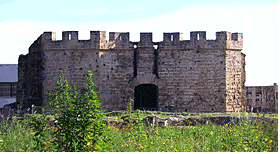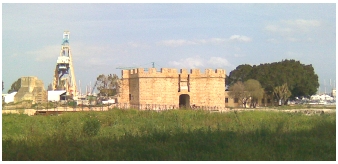...Best of Sicily presents... Best of Sicily Magazine. ... Dedicated to Sicilian art, culture, history, people, places and all things Sicilian. |
by Antonella Gallo | |||
Magazine Index Best of Sicily Arts & Culture Fashion Food & Wine History & Society About Us Travel Faqs Contact Map of Sicily
|
The area of Palermo boasts several castles and fortified medieval dwellings: hilltop Castellaccio (above Monreale), the Steri, the Norman Palace, the Zisa, the Cuba. Elsewhere in Sicily there stand imposing coastal fortresses, such as those at Milazzo and Siracusa, and mountaintop feudal castles like those at Erice, Caccamo and Mussomeli. Nevertheless, Castello al Mare has a particularly distinguished history. It was already a minor seaside fortification in Arab times, flanking the slave-trading quarter outside the city of Bal'harm, its drinking water supplied by the sophisticated kanat (qanat) system of underground channels. The structure seems not to have figured much in the battle which led to the conquest of Bal'harm in 1071. The Orthodox Church of Saint Peter was built nearby, dedicated by Robert Guiscard and his wife, Sichelgaita, in 1081. (An engraved stone inscription commemorating their patronage is preserved in the Palazzo Abatellis art museum.)
Well into the Spanish era Castello al Mare remained the city's principal coastal defence. Barbary pirates occasionally made their way past the other naval defences to raid the area to the east, which earned the name Acque dei Corsari (Corsairs' Waters). Watch towers (such as those still standing at Mondello to the west of Palermo) and the seaside wall (Mura delle Cattive) did little to dissuade the zealous pirates, though they usually concentrated their attacks on Sicily's southern and Ionian coasts. Local rioting during 1860 and in the years following led to the destruction of most of the castle as Palermitans brought down the walls and appropriated the stones to build homes in the vicinity. What remained of the castle was abandoned, and following the Second World War some buildings were illegally erected around it. It has been partially restored but is rarely open to the public. Castello al Mare is easy to find. From Via Roma or the Teatro Massimo district, follow Via Cavour to the coastal street (Via Crispi). Looking across Piazza 13 Vittime and the steel monument to Mafia victims, the castle and round tower are visible beyond a grassy field. A serene corner in a bustling city. About the Author: Antonella Gallo, who teaches art in Rome, has written numerous articles on arts and artists for Best of Sicily. | ||
Top of Page |
 Castello al Mare (Castle by the Sea) may not be invisible, but to the
Palermitans it is a local secret rarely shared with outsiders. Truth be
told, little remains of it beyond the gatehouse (shown here), part of a
large round tower and the foundations of its moat. Like
Castello al Mare (Castle by the Sea) may not be invisible, but to the
Palermitans it is a local secret rarely shared with outsiders. Truth be
told, little remains of it beyond the gatehouse (shown here), part of a
large round tower and the foundations of its moat. Like  The
The